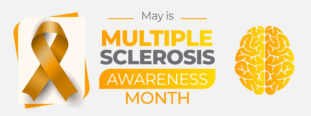ACTRIMS/ECTRIMS 2014 – Part 1
Update on oral therapies
Gilenya
Tecfidera
Aubagio
Drug vs. drug
The annual congress of the European Committee on Treatment and Research in MS (ECTRIMS), held this year in conjunction with the Americas Committee (ACTRIMS), is the largest MS meeting of the year and provided results for about 1,000 new research studies. The following is a summary of new data on the three oral MS therapies currently available: Gilenya (fingolimod), Tecfidera (dimethyl fumarate) and Aubagio (teriflunomide). The three themes at this year’s meeting were effectiveness, safety, and how one drug compares to another.
Gilenya
An emerging concept in MS is “disease activity-free” (DAF) or “no evidence of disease activity” (NEDA), which may become the new benchmark for the effectiveness of a treatment. What DAF/NEDA means is that a person has no relapses, no new inflammatory activity on their MRI, and no disability progression (as measured by the EDSS scale). (This topic was addressed in Can you be MS-free? MSology, Oct. 25, 2012).
In looking at people enrolled in two phase III studies (FREEDOMS and FREEDOMS II), researchers found that people taking Gilenya were 3.5 times more likely to achieve NEDA than those taking a placebo over the two-year study period (Bergvall and colleagues. ECTRIMS 2014; abstract P112). In the FREEDOMS study, 33% of people on Gilenya had no disease activity at two years (Kappos and colleagues. AAN 2011; abstract PD6.002).
MS centres in Germany are conducting an ongoing five-year study of people taking Gilenya to evaluate the drug’s efficacy and safety (Ziemssen and colleagues. ECTRIMS 2014; abstract P107). Thus far, the PANGAEA study has found that two-thirds of people had no relapses in the first and second years of treatment, most had stable disability scores (85% in year 1, 94% in year 2), and 98% of people taking Gilenya said the tolerability was good or very good.
One issue with Gilenya is the drug’s effects on the heart. The START study is examining the impact of the drug on heart function in the first week of treatment and plans to enroll about 7,000 people (Limmroth and colleagues. ECTRIMS 2014; abstract P086). To date, less than 1% of people have experienced a low heart rate (less than 45 beats per minute) during the six-hour observation period. The heart effects of the drug were transient, and no longer detectable after a week on treatment. A separate study of 906 people treated with Gilenya in Italy reported that in the first six months, the most common side effects were headache (4% of people), influenza (2%) and fatigue (2%) (Laroni and colleagues. ECTRIMS 2014; abstract P083). Overall, 3-4% of people stopped therapy because of side effects.
An underappreciated issue in MS is the effect of the disease on cognitive function (thinking, planning, memory, processing speed, etc.). A novel study looked at this issue and found that cognition was stable or slightly improved during one year of treatment with Gilenya (Barak and colleagues. ECTRIMS 2014; abstract P322). A separate study reported that other MS therapies (interferons, Copaxone, Tysabri) may stabilize cognitive function, although there was less of a benefit when it came to memory (Graves and colleagues. ECTRIMS 2014; abstract P159).
Tecfidera
Two phase III studies looked at Tecfidera in MS (DEFINE and CONFIRM), and people completing those two-year studies had the option of enrolling in a long-term observational study (called ENDORSE). In the first two years of controlled study, the annualized relapse rate was low (0.17 in DEFINE, 0.22 in CONFIRM) with twice-daily Tecfidera, and was lower still during ENDORSE (0.163 in the first year, 0.138 in the second year), which may indicate that treatment continues to be effective (Gold and colleagues. ECTRIMS 2014; abstract P110). Relapse rates were similarly low once people initially taking placebo or Copaxone switched to Tecfidera. Most people continuing on treatment also had no inflammatory activity on their MRI (Arnold and colleagues. ECTRIMS 2014; abstract P059). A limitation of these studies is that 30% of the original trial participants dropped out of the trials, so the ENDORSE results represent only two-thirds of the original sample (one-quarter for the MRI results).
With increasing use of Tecfidera at MS clinics, one U.S. centre reported its experience with Tecfidera in 145 people (Chaves and colleagues. ECTRIMS 2014; abstract P303). The most common reason for switching to Tecfidera was side effects with one of the injectables. Flushing was the most common side effect when starting Tecfidera, and occurred in a majority of people (57% in the first month). The incidence of flushing declined by the third month (reported by 35%), then became more common again (reported by 45% in month 6, 71% in month 9). So flushing appears to be a persistent problem. Gastrointestinal upset (stomach ache, nausea/vomiting, etc.) was a problem for most people in the first month of treatment, but declined in frequency thereafter (to 11% by month 9). The rate of serious infections (3.4%) was low; abnormal liver function tests were more common than expected (up to 19%). Very few people had problems with relapses (5.5%). A total of 16% of people stopped treatment because of side effects.
Tolerability has been a key issue with Tecfidera so the MANAGE study looked at the kinds of remedies people were taking for their stomach problems (Fox and colleagues. ECTRIMS 2014; abstract P309). Almost half (46%) took something in the first month, but this went down to 28% in the second month and 18% in the third month of Tecfidera, suggesting that the problem was becoming less common or acute. The preferred stomach remedies were Pepto-Bismol, drugs that work on stomach acid (e.g. Losec, Zantac, Pepcid, etc.), anti-diarrheal drugs (e.g. Imodium), anti-nausea drugs and a variety of things to treat bloating and constipation. Tecfidera was better tolerated when taken with food: stomach effects were rated as “severe” or “extreme” in 10% of people who took it with a meal compared to 19% who took it on an empty stomach.
Aubagio
The two key phase III studies of Aubagio were TEMSO and TOWER, which showed that the 14-mg dose was effective in reducing relapses and slowing disability progression. In looking at the pooled results for all 2,251 people in those trials, researchers found that the drug’s impact on relapse rates was similar if a person had never received an MS treatment compared to those switched from another therapy (Freedman and colleagues. ECTRIMS 2014; abstract P046). Relapse rates were reduced 36% in untreated people, 28% in people who had been on one prior therapy, and 47% for those on more than one prior therapy. The 7-mg dose had a similar impact on relapses as the 14-mg dose, but the higher dose was more effective in reducing disability progression.
Drug vs. drug
With 10 drugs now available to treat MS, it’s tempting to compare one with the other, if only indirectly (few studies have directly compared treatments). Two new studies match up Tecfidera with Gilenya. One analysis looked at U.S. pharmacy mail order data for 9,546 people, most of whom were taking Tecfidera. Overall, 37% of people taking Tecfidera stopped taking it over a six-month period compared to 23% of those taking Gilenya (Bergvall and colleagues. ECTRIMS 2014; abstract P289). This may indicate that a fair number of people are dissatisfied with their treatment, although interpreting these sorts of studies is very difficult.
A more direct comparison was made of 743 people attending the Cleveland clinic who started Tecfidera or Gilenya (Cohn and colleagues. ECTRIMS 2014; abstract P300). Overall, 18% of people stopped taking Tecfidera within the first three months, compared to 8% of those starting Gilenya. The most common reasons for stopping Tecfidera were stomach upset and flushing. The two treatments were similarly effective with respect to MRI findings, but there was a trend for more people to have relapses on Tecfidera (differences were not significant).
Share this article
Facebook Twitter pin it! Email
Related Posts
Back





